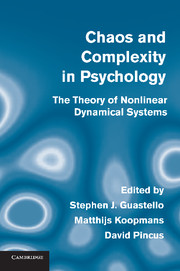Book contents
- Frontmatter
- Contents
- Contributors
- Preface
- 1 Introduction to Nonlinear Dynamics and Complexity
- 2 Collective Intelligence: Observations and Models
- 3 Neurodynamics and Electrocortical Activity
- 4 Psychophysics
- 5 Temporal and Spatial Patterns in Perceptual Behavior: Implications for Dynamical Structure
- 6 Embodied and Embedded: The Dynamics of Extracting Perceptual Visual Invariants
- 7 Origins of Order in Cognitive Activity
- 8 Nonlinear Complex Dynamical Systems in Developmental Psychology
- 9 Developmental Psychopathology: Maladaptive and Adaptive Attractors in Children's Close Relationships
- 10 Psychopathology
- 11 Coherence, Complexity, and Information Flow: Self-Organizing Processes in Psychotherapy
- 12 The Dynamics of Human Experience: Fundamentals of Dynamical Social Psychology
- 13 Group Dynamics: Adaptation, Coordination, and the Emergence of Leaders
- 14 Organizational Psychology
- 15 Complexity, Evolution, and Organizational Behavior
- 16 Agent-Based Modeling Within a Dynamic Network
- 17 Epilogue: Psychology at the Edge of Chaos
- Index
2 - Collective Intelligence: Observations and Models
Published online by Cambridge University Press: 18 December 2013
- Frontmatter
- Contents
- Contributors
- Preface
- 1 Introduction to Nonlinear Dynamics and Complexity
- 2 Collective Intelligence: Observations and Models
- 3 Neurodynamics and Electrocortical Activity
- 4 Psychophysics
- 5 Temporal and Spatial Patterns in Perceptual Behavior: Implications for Dynamical Structure
- 6 Embodied and Embedded: The Dynamics of Extracting Perceptual Visual Invariants
- 7 Origins of Order in Cognitive Activity
- 8 Nonlinear Complex Dynamical Systems in Developmental Psychology
- 9 Developmental Psychopathology: Maladaptive and Adaptive Attractors in Children's Close Relationships
- 10 Psychopathology
- 11 Coherence, Complexity, and Information Flow: Self-Organizing Processes in Psychotherapy
- 12 The Dynamics of Human Experience: Fundamentals of Dynamical Social Psychology
- 13 Group Dynamics: Adaptation, Coordination, and the Emergence of Leaders
- 14 Organizational Psychology
- 15 Complexity, Evolution, and Organizational Behavior
- 16 Agent-Based Modeling Within a Dynamic Network
- 17 Epilogue: Psychology at the Edge of Chaos
- Index
Summary
An organism is a complex, definitely coordinated and therefore individualized system of activities, which are primarily directed to obtaining and assimilating substances from an environment, to producing other similar systems, known as offspring, and to protecting the system itself and usually also its offspring from disturbances emanating from the environment.
(Wheeler, 1911, p. 308)Introduction
Collective intelligence refers to collective behavior that is stably correlated with ecologically meaningful features of the environment, salient for the survival of the collective, adaptive to changes in the environment, and that transcends the capability of any single member of the collective. Social insect colonies provide an ideal subject for study because they comprise a large number of individuals that can be easily maintained in laboratory environments and are readily reproduced, thus providing an opportunity for the replication of statistically robust experiments. The American myrmecologist W. M. Wheeler was the first to propose the idea of the social insect colony as an organism in its own right, having the ability to regulate both its behavior and its environment to fulfill particular salient needs. The colony is able to do all of this in the absence of a central authority through the interactions among and activities of its individual members, none of whom possesses the cognitive and physical abilities to carry out these tasks on its own. The social insect colony provides the prototypical example of a collective intelligence.
- Type
- Chapter
- Information
- Chaos and Complexity in PsychologyThe Theory of Nonlinear Dynamical Systems, pp. 41 - 72Publisher: Cambridge University PressPrint publication year: 2008
- 2
- Cited by



